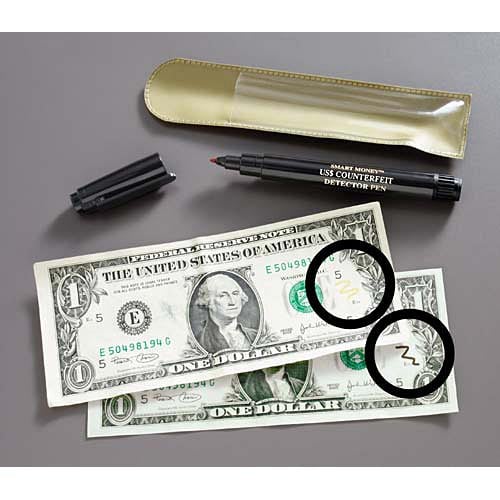


In the continuing arms race against counterfeit money criminals, one of the  newest weapons introduced is the revised money tester pen. Its predecessor, which used iodine-based ink to test chemicals found on paper money, was forced into ignominious retirement after counterfeiters found a way to countermand the chemical effect indicating fake bills, and create false positives with a trip to the local office supply store or hairspray. This new version works on a slightly different basis, testing the ink on the paper rather than the paper itself.
newest weapons introduced is the revised money tester pen. Its predecessor, which used iodine-based ink to test chemicals found on paper money, was forced into ignominious retirement after counterfeiters found a way to countermand the chemical effect indicating fake bills, and create false positives with a trip to the local office supply store or hairspray. This new version works on a slightly different basis, testing the ink on the paper rather than the paper itself.
No chemical reactions needed with the newer model: simply smear the pen on the bill you are trying to test, and if it lifts off any ink, or blurs the ink on the paper, you have found a counterfeit. This is a more effective strategy than iodine-testing; however, it still leaves itself vulnerable to more advanced operations, including washed money and the “SuperNotes” that make up an increasing amount of counterfeits in circulation.
The ink-testing “pens” are really more a mix between glue gun and eraser, relying on picking up ink from low-end counterfeit money – the kind made on printers and copiers. Because the ink in these bogus bills is printed on top of the paper, it can be easily taken off. Conversely, genuine dollars are printed with offset presses, which forces the ink into the paper.
There are at least two obvious ways to get around this problem. First, procuring a heavy press to create the same ink-filled paper effect as on genuine currency. This is most commonly the road chosen by large-scale organized counterfeiting operations: South American drug cartels, and hostile regimes like North Korea, Iran and Russia. All of these organizations can push out hundreds of thousands of 100-dollar bills called “supernotes” that are virtually indistinguishable in look and feel to real dollars, but without the UV security features.
Now consider the value of such a device. A pack of pens sells for around $60 - $70 dollars, slightly less than the standard Fraud Fighter UV Light Detector. What do you get for that money? A counterfeit detection device that will not detect the offset-printed washed notes and the foreign government supernotes, which make up an already high and ever-growing proportion of counterfeits in circulation – in other words a device that will work properly possibly half of the time. Each pen is only good for about 1,000 tests – which can take a week or even a couple days in some of the cash-heavier establishments, and a lot less if you forget to replace the cap after each application.
Compare that cost with ultraviolet detector products, which work on an unlimited amount of bills, can last as long as five years, and of course will spot even bleached bills and supernotes, and the choice is clear. You can be penny-wise in deciding to get a cheaper counterfeit-detector pen, but pound – or in this case $100 – foolish when your pen misses a counterfeit note.
Oh! And by-the-way, the UV detectors also enable you to verify credit cards, driver licenses, cashier’s checks, money orders, passports and a whole bunch of other important documents.


.png)
